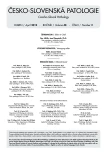-
Medical journals
- Career
Neuropathological diagnostics in pediatric oncology from the clinical point of view
Authors: D. Sumerauer; M. Zápotocký
Authors‘ workplace: Klinika dětské hematologie o onkologie UK 2. LF a FN Motol, Praha
Published in: Čes.-slov. Patol., 48, 2012, No. 2, p. 72-74
Category: Review Articles – Neuropathology
Overview
Treatment of pediatric brain tumors in children and adolescents is a tremendous challenge for the treating physicians, requiring a multidisciplinary approach and co-operation of multiple sub-specialities. Considerable progress in diagnostics and treatment of brain tumors has been made in recent years. In many brain tumors, especially embryonal brain tumors important, clinically relevant bio markers, were identified and are increasingly used in patient stratification into risk groups. Collaboration between clinicians, pathologists and molecular biologists is essential for successful therapy. This article gives some examples of collaboration in pediatric neuro-oncology.
Keywords:
brain tumors – neuropathology – treatment
Sources
1. Louis DN, Oghaki H, Wiestler OD, et al., The 2007 WHO classification of tumors of the central nervous system. Acta Neuropathol 2007; 114(2): 97–109.
2. Ellison DW, Kocak M, Dalton J, et al., Definition of Disease-Risk Stratification Groups in Childhood Medulloblastoma Using Combined Clinical, Pathologic and Molecular Variables. J Clin Oncol 2010; 29(11): 1400–1407.
3. Pizer BL, Clifford SC, The potential impact of tumour biology on impoved clinical practice for medulloblastoma: progress towards biologically driven clinical trials. Br J Nerosurg 2009; 23(4): 364–375.
4. von Bueren AO, von Hoff K, Pietsch T, et al., Treatment of young children with localized medulloblastoma by chemotherapy alone: results of the prospective, multicenter trial HIT 2000 confirming the prognostic impact of histology. Neuro Oncol 2011; 13(6): 669–679.
5. Pfister SM, Korshunov A, Kool M, Hasselblatt M, Eberhart C, Taylor MD, Molecular diagnostics of CNS embryonal tumors. Acta Neuropathol 2010; 120(5): 553–566.
6. Eaton KW, Tooke LS, Wainwright LM, Judkins AR, Biegel JA, Spectrum of SMARCB1/INI1 mutations in familial and sporadic rhabdoid tumors. Pediatr Blood Cancer 2011; 56(1): 7–15.
7. von Hoff K, Hinkes B, Dannenmann-Stern E, et al., Frequency, risk-factors and survival of children with atypical teratoid rhabdoid tumors (AT/RT) of the CNS diagnosed between 1988 and 2004, and registered to the German HIT database. Pediatr Blood Cancer 2011; 57(6): 978–985.
8. Woehrer A, Slavc I, Waldhoer T, et al., Incidence of atypical teratoid/rhabdoid tumors in children: a population-based study by the Austrian Brain Tumor Registry, 1996-2006. Cancer 2010; 116(24): 5725–5732.
9. Kilday JP, Rahman R, Dyer S, et al., Pediatric ependymoma: biological perspectives. Mol Cancer Res 2009; 7(6): 765–786.
10. Witt H, Mack SC, Ryzhova M, et al., Delineation of Two Clinically and Molecularly Distinct Subgroups of Posterior Fossa Epandymoma. Cancer Cell 2011; 20(2): 143–157.
11. Pfister SM, Hartman C, Korshunov A, Histology and Molecular Pathology of Pediatric Brain Tumors, J Child Neurol 2009; 24(11): 1375–1386.
12. Cohen KJ, Pollack IF, Zhou T, et al., Temozolomide in the treatment of high-grade gliomas in children: a report from the Children’s Oncology Group. Neuro Oncol 2011; 13(3): 317–323.
13. MacDonald TJ, Aguilera D, Kramm CM, Treatment of high-grade glioma in children and adolescents. Neuro Oncol 2011; 13(10): 1049–1058.
14. Angelini P, Hawkins C, Laperriere N, Bouffet E, Bartels U, Post mortem examinations in diffuse intrinsic pontine glioma: challenges and chances. J Neurooncol 2011; 101(1): 75–81.
Labels
Anatomical pathology Forensic medical examiner Toxicology
Article was published inCzecho-Slovak Pathology

2012 Issue 2-
All articles in this issue
- Neurodegenerative Disorders: Review of Current Classification and Diagnostic Neuropathological Criteria
-
José Juan Verocay, „el patólogo de Praga“
(ke 100. výročí jeho pražské habilitace) - Selected biomarkers in the primary tumors of the central nervous system: short review
- Neuropathological diagnostics in pediatric oncology from the clinical point of view
- Neuropathology of refractory epilepsy: the structural basis and mechanisms of epileptogenesis
- Micropapillary urothelial carcinoma of the ureter
- Myxoid mixed low-grade endometrial stromal sarcoma and smooth muscle tumor of the uterus. Case report
- Mediastinal ganglioneuroma with perineural cell differentiation. Report of a case
- Peripheral neuropathy in Whipple’s disease: A case report
- Czecho-Slovak Pathology
- Journal archive
- Current issue
- Online only
- About the journal
Most read in this issue- Neurodegenerative Disorders: Review of Current Classification and Diagnostic Neuropathological Criteria
- Neuropathology of refractory epilepsy: the structural basis and mechanisms of epileptogenesis
- Selected biomarkers in the primary tumors of the central nervous system: short review
- Peripheral neuropathy in Whipple’s disease: A case report
Login#ADS_BOTTOM_SCRIPTS#Forgotten passwordEnter the email address that you registered with. We will send you instructions on how to set a new password.
- Career
